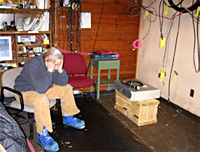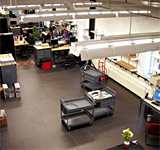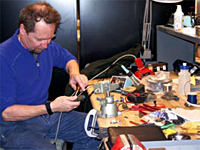 South Pole carpenter
Jason Hunter assembles a casing for researcher Steven Mende’s electron precipitation all-sky camera. South Pole Skylab Transition Keeps Sci Techs On the MoveBy Peter Rejcek, Sun staffMulti-tasking is one of those trendy words that has entered the lexicon in recent years. For someone like Neal Scheibe, it’s a job description. “There’s days when I’m digging holes. There’s days when I’m moving stuff. There’s days when I’m trying to calibrate equipment. There’s days when I’m troubleshooting software. There’s days when I’m troubleshooting hardware,” Scheibe said. Scheibe is a research associate at the South Pole. His job for the next year is to ensure that the science projects operate smoothly throughout the 24-hour winter night. But this year he and fellow research associate Bob Melville have another ball to juggle: the transition of project equipment from the Skylab science building to the new science wing of the elevated station. “It was a Herculean effort,” Al Baker said of removing equipment associated with a dozen different science projects to the new science lab, as well as to the Atmospheric Research Observatory in the Clean Air Sector, a region several hundred meters upwind from the station. Baker is the science support coordinator for Raytheon Polar Services Co., and he’s tasked with overseeing the transition. The physical move involved a number of groups at the station, including science support, IT, South Pole Station Modernization personnel, and the facilities, engineering, maintenance and construction department. “By working together as one big, happy family, a big team, we were actually able to get it moved,” Baker said. “The coordination … was very interesting.” Skylab, an orange tower-like building half-buried in the snow, is now vacant and cold. Visiting scientists and the research associates, commonly referred to as science techs, are currently busy recalibrating equipment and getting projects back online. Their deadline to be fully operational is mid-February, when the last flight leaves Pole until late October. Helping move the process along is the willingness of the scientists and others to work on projects not directly related to their research, Baker said. “It’s fieldwork for other grantees. … This is unprecedented.” Outgoing meteorologist Russ Durke was also involved in some of the most difficult work in emptying Skylab, Baker added.  Research associate Dana Hrubes sits in the
empty Cusp laboratory in the Skylab science building in early November. He’s spent three winters at the South Pole as a research associate, or science tech, with some of that time in Skylab. He said he’s sad to see the old building go. A couple of projects are already up and running, including a Stanford University experiment using a very low frequency beacon receiver that continuously monitors electrons from Earth’s magnetosphere. “It’s very cool to see it coming up,” Baker said of the new lab. Skylab Goes ColdIt was equally disheartening to see the iconic Skylab building empty out, he added. “It’s really sad to leave an old [lab] with so much history.” Skylab was built in the early 1970s when the Dome and its ancillary station buildings were constructed. The four-story building housed three separate labs, Aurora, Cusp and Cosray. An archway in the back of the Dome served as the main entrance. On the third floor was a popular lounge and music room, where Polies could escape and enjoy a rare outdoor view from indoors before the elevated station was built. Dana Hrubes is intimately familiar with Skylab. Since 2001, he’s spent more than three years of his life at the Pole. Most recently, he went 26 months with only a 60-day break sandwiched between tours, and left last November. His final weeks were partly spent documenting and disassembling the Skylab’s electronics racks and putting them back together in the new science area. Hrubes said he believes the new station “will work out fine,” but it’s not a change he can easily digest. While the new lab is spacious, it’s one large room partitioned by desks and cubicle walls. In Skylab, the science projects were squirreled away in separate labs.  The science wing in the new
elevated station is more spacious than the Skylab science building, with room to grow. “I will miss the easy access to the outside through the doors in Skylab and miss walking to Skylab from the Dome through the … ice tunnel that served as a constant reminder of where we were working,” Hrubes said via e-mail. The veteran tech said he expects to spend the winter at Pole again in 2007. “For me, it was sad to see Skylab abandoned,” he added. A New BeginningBefore the summer season began, the new science wing (B2 in official terminology) was merely a warehouse. The meteorological department, which occupies a corner of the room, was the first science group to move from its offices under the Dome and into the new station. Baker said while it’s a busy time for the science techs, it’s also an exciting one because they will be the first to leave their mark on the new science wing. “These guys will have built their own lab,” he explained, referring to how the science techs can organize and design how the new space looks. “It wasn’t built by the [National Science Foundation] or some supervisor from corporate. The person working in the lab actually gets to build it from the ground up.” Scheibe and Melville, along with South Pole cryogenic technician Mark Noske, are all first-year Polies, according to Baker. That’s another difference for science support this year over past seasons. Scheibe said he believes their inexperience is good and bad. They’ve had to undergo a crash course in atmospheric science, along with details about the equipment they’ll maintain, but they’re not burdened by preconceived notions of how the lab is supposed to operate. “I think we benefit from not knowing better,” he said. Melville, back in the lab after a long day troubleshooting equipment outside with scientist Dan Detrick, said he was surprised at how modern the new station and B2 wing are. He arrived at the beginning of the summer season, and watched the new lab grow and mature daily.  Researcher Dan Detrick repairs equipment
in the new science lab in the elevated station. “What was most impressive is that we found everything,” he said of locating equipment after Skylab was emptied. Jack-Of-All-TradesFinding good South Pole science techs is also not easy, Baker said, especially this year with the transition. A tech must have a strong background in electronics, computers and hardware, he said. There are also less tangible elements to the job. “I need the [scientist] to feel confident that this tech is his hands and eyes and head for nine months while he’s 10,000 miles away.” Hrubes, for example, built a solid reputation among the science community. Allan Weatherwax, a principal investigator on a couple of Antarctic atmospheric projects, is one of several scientists whose equipment was moved out of Skylab. He said he had asked specifically that Hrubes, with his extensive experience, assist with the initial transition. “We joke that [Dana Hrubes] knows the instruments better than we do,” Weatherwax had said during an unrelated interview earlier this season. “It was tremendously helpful to have him there.” Hrubes has a bachelor’s degree in mechanical engineering from the Illinois Institute of Technology and a master’s degree from MIT in aeronautics and astronautics. He also has more than 30 years of experience as a research engineer. But, he said, at South Pole it’s not always what you have on paper that counts. Techs are responsible for multiple projects, work all hours of the day and get plenty of outdoor exercise. He would walk as much as four kilometers a day between buildings in the winter, shedding quite a bit of weight along the way. “With that many projects, there is almost always something failing that requires special attention in addition to regular daily duties,” Hrubes noted. “You need to be very organized and methodical.” An electrical engineer-turned-professor, Melville’s had a good initiation into what it takes to be a South Pole science tech. On a recent Friday night when most station personnel were winding down from work and getting ready for the Christmas holiday, he was suiting up in his extreme cold weather gear for a foray outside. “I like it,” he said eagerly, shrugging off the long workday. “Where I earn my money, is when something breaks.” Also an electrical engineer, Scheibe left a lucrative career in the semi-conductor industry for a chance to work at Pole. And like Melville, he seems eager for the challenge of winter, when he becomes responsible for a whole season’s worth of valuable data. “I don’t think the pressure has really sunk in yet,” he said. “I don’t really perceive it as pressure, but as an opportunity to learn. “I’m just living one day at a time.” NSF-funded research in this story: Jaakko Putkonen, University of Washington. |



For USAP Participants |
For The Public |
For Researchers and EducatorsContact UsU.S. National Science FoundationOffice of Polar Programs Geosciences Directorate 2415 Eisenhower Avenue, Suite W7100 Alexandria, VA 22314 Sign up for the NSF Office of Polar Programs newsletter and events. Feedback Form |

